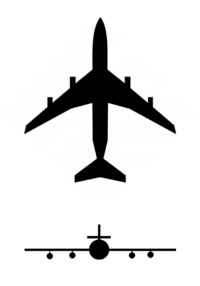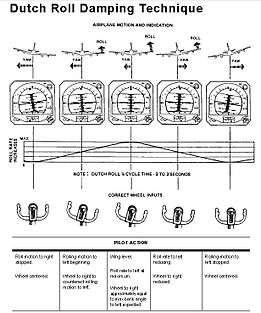Dutch roll


Dutch roll is a type of aircraft motion, consisting of an out-of-phase combination of "tail-wagging" and rocking from side to side. This yaw-roll coupling is one of the basic flight dynamic modes (others include phugoid, short period, and spiral divergence). This motion is normally well damped in most light aircraft, though some aircraft with well-damped Dutch roll modes can experience a degradation in damping as airspeed decreases and altitude increases. Dutch roll stability can be artificially increased by the installation of a yaw damper. Wings placed well above the center of mass, sweepback (swept wings) and dihedral wings tend to increase the roll restoring force, and therefore increase the Dutch roll tendencies; this is why high-winged aircraft often are slightly anhedral, and transport-category swept-wing aircraft are equipped with yaw dampers.
Stability
In aircraft design, Dutch roll results from relatively weaker positive directional stability as opposed to positive lateral stability. When an aircraft rolls around the longitudinal axis, a sideslip is introduced into the relative wind in the direction of the rolling motion. Strong lateral stability begins to restore the aircraft to level flight. At the same time, somewhat weaker directional stability attempts to correct the sideslip by aligning the aircraft with the perceived relative wind. Since directional stability is weaker than lateral stability for the particular aircraft, the restoring yaw motion lags significantly behind the restoring roll motion. As such, the aircraft passes through level flight as the yawing motion is continuing in the direction of the original roll. At that point, the sideslip is introduced in the opposite direction and the process is reversed.
Mechanism
The most common mechanism of Dutch roll occurrence is a moment of yawing motion which can be caused by any number of factors. As a swept-wing aircraft yaws (to the right, for instance), the left wing becomes less-swept than the right wing in reference to the relative wind. Because of this, the left wing develops more lift than the right wing causing the aircraft to roll to the right. This motion continues until the yaw angle of the aircraft reaches the point where the vertical stabilizer effectively becomes a wind vane and reverses the yawing motion. As the aircraft yaws back to the left, the right wing then becomes less swept than the left resulting in the right wing developing more lift than the left. The aircraft then rolls to the left as the yaw angle again reaches the point where the aircraft wind-vanes back the other direction and the whole process repeats itself. The average duration of a Dutch roll half-cycle is 2 to 3 seconds.
The Dutch roll mode can be excited by any use of aileron or rudder, but for flight test purposes it is usually excited with a rudder singlet (short, sharp motions of the rudder to a specified angle, and then back to the centered position) or doublet (a pair of such motions in opposite directions). Some larger aircraft are better excited with aileron inputs. Periods can range from a few seconds for light aircraft to a minute or more for airliners.
Rolling on a heading
Dutch roll is also the name (considered by professionals to be a misnomer) given to a coordination maneuver generally taught to student pilots to help them improve their "stick-and-rudder" technique. The aircraft is alternately rolled as much as 60 degrees left and right while rudder is applied to keep the nose of the aircraft pointed at a fixed point. More correctly, this is a rudder coordination practice exercise, to teach a student pilot how to correct for the effect known as adverse aileron yaw during roll inputs.
This coordination technique is better referred to as "rolling on a heading", wherein the aircraft is rolled in such a way as to maintain an accurate heading without the nose moving from side-to-side (or yawing). The yaw motion is induced through the use of ailerons alone due to aileron drag, wherein the lifting wing (aileron down) is doing more work than the descending wing (aileron up) and therefore creates more drag, forcing the lifting wing back, yawing the aircraft toward it. This yawing effect produced by rolling motion is known as adverse yaw. This has to be countered precisely by application of rudder in the same direction as the aileron control (left stick, left rudder - right stick, right rudder). This is known as synchronised controls when done properly, and is difficult to learn and apply well. The correct amount of rudder to apply with aileron is different for each aircraft.
Name
The origin of the name Dutch roll is uncertain. However, it is likely that this term, describing a lateral asymmetric motion of an airplane, was borrowed from a reference to similar-appearing motion in ice skating. In 1916, aeronautical engineer Jerome C. Hunsaker published the following quote: "Dutch roll – the third element in the [lateral] motion [of an airplane] is a yawing to the right and left, combined with rolling. The motion is oscillatory of period for 7 to 12 seconds, which may or may not be damped. The analogy to 'Dutch Roll' or 'Outer Edge' in ice skating is obvious."[1] In 1916, Dutch Roll was the term used for skating repetitively to right and left (by analogy to the motion described for the aircraft) on the outer edge of one's skates. By 1916, the term had been imported from skating to aeronautical engineering, perhaps by Hunsaker himself. 1916 was only five years after G. H. Bryan did the first mathematical analysis of lateral motion of aircraft in 1911.[2]
Accidents
On October 30, 2015 a Leonardo-Finmeccanica-Helicopters Division (formerly AgustaWestland) AW609 prototype crashed in Italy killing its two pilots. Further investigation by the Italian ANSV established a Dutch roll during a high-speed test could be the cause.[3][4]
Air Transat Flight 961, an Airbus A310, was involved in a Dutch roll incident following structural failure of the rudder at cruising altitude after departure from Juan Gualberto Gomez Airport, Varadero, Cuba, on March 6, 2005. The aircraft returned to the airport with one flight attendant slightly injured and with serious structural damage.
See also
References
- ↑ Hunsaker, Jerome (1916). "Proceedings of the National Academy of Sciences of America". 2: 282.
- ↑ Bryan, G. H. (1911). Stability in Aviation. p. 123.
- ↑ http://www.verticalmag.com/news/article/AgustaWestlandAW609wasperforminghighspeedtestsondayofcrash
- ↑ http://www.ansv.it/cgi-bin/ita/AW609%20N609AG%20interim%20statement%20and%20safety%20recommendations.pdf
External links
- "Так самолеты не летают 2" (from 46 sec) - presumably Dutch roll occurrence during the test flight (no passengers) of the Tupolev airliner, anecdotal information pointing to the yaw damper malfunction as the cause. Aircraft had been landed safely.
- How to Halt Dutch Roll
- What Is Dutch Roll, And How Do You Prevent It? (Bold Method, 2015-07-28)